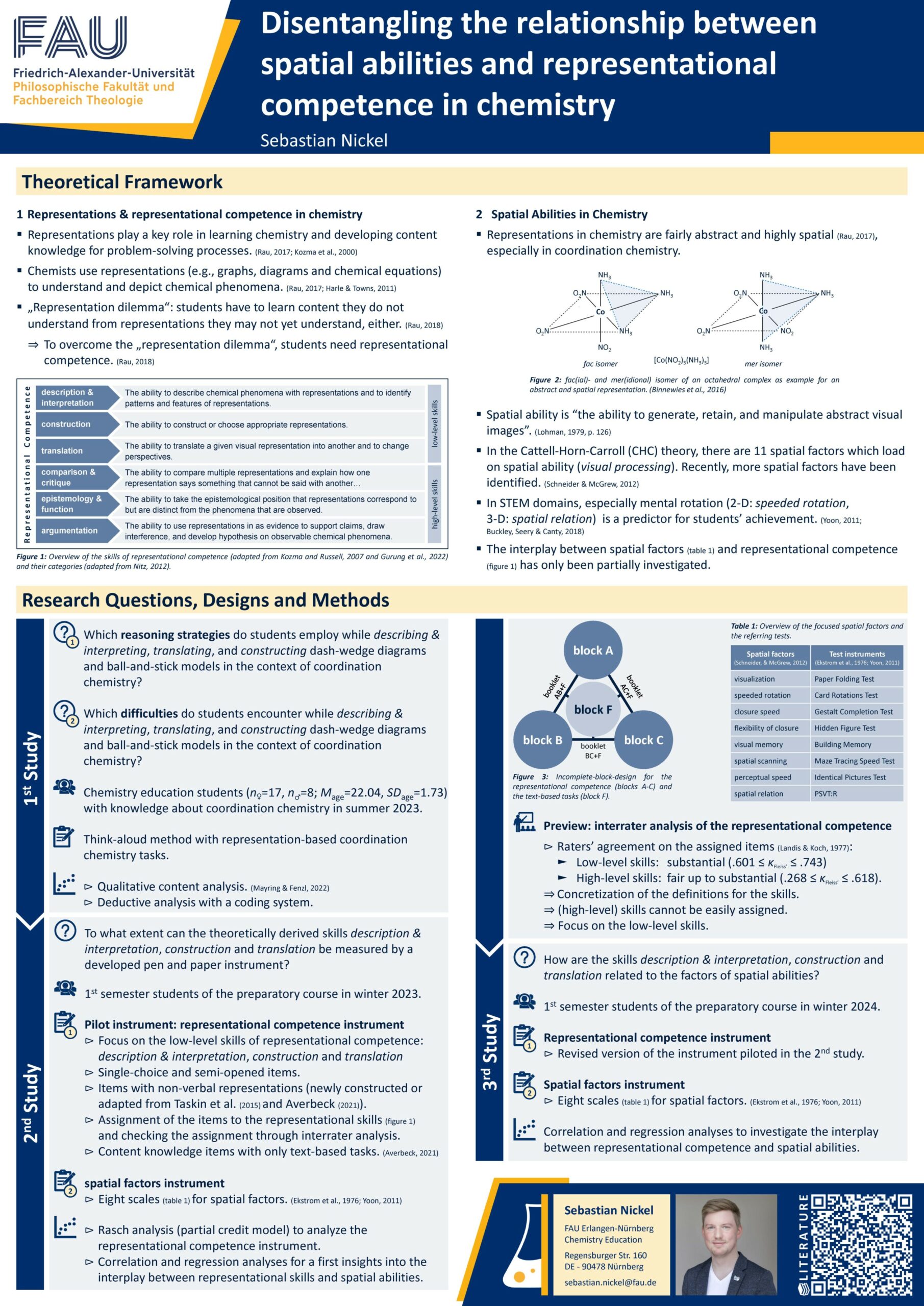Disentangling the relationship between spatial abilities and representational competence in chemistry

Download
Literature
- Averbeck, D. (2021). Zum Studienerfolg in der Studieneingangsphase des Chemiestudiums: Der Einfluss kognitiver und affektiv-motivationaler Variablen. Berlin: Logos.
- Binnewies, M., Finze, M., Jäckel, M., Schmidt, P., Willner, H., & Rayner-Canham, G. (2016). Allgemeine und Anorganische Chemie. Berlin: Springer.
- Buckley, J., Seery, N., & Canty, D. (2018). A Heuristic Framework of Spatial Ability: a Review and Synthesis of Spatial Factor Literature to Support its Translation into STEM Education. Educational Psychology Review, 30(3), pp. 947-972. doi:10.1007/s10648-018-9432-z
- Ekstrom, R. B., French, J. W., Harman, H. H., & Derman, D. (1976). Manual for kit of factor-referenced cognitive tests. Princeton (NJ): Education Testing Service.
- Gurung, E., Jacob, R., Bunch, Z., Thompson, B., & Popova, M. (2022). Evaluating the Effectiveness of Organic Chemistry Textbooks for Promoting Representational Competence. Journal of Chemical Education, 99(5), pp. 2044-2054. doi:10.1021/acs.jchemed.1c01054
- Harle, M., & Towns, M. (2011). A Review of Spatial Ability Literature, Its Connection to Chemistry, and Implications for Instruction. Journal of Chemical Education, 88(3), pp. 351-360. doi:10.1021/ed900003n
- Kozma, R., & Russell, J. (2007). Students Becoming Chemists: Developing Representational Competence. In J. K. Gilbert (Ed.), Visualization in Science Education (pp. 121-146). Dordrecht: Springer. doi:10.1007/1-4020-3613-2_15
- Kozma, R., Chin, E., Russell, J., & Marx, N. (2000). The Roles of Representations and Tools in the Chemistry Laboratory and Their Implications for Chemistry Learning. Journal of the Learning Sciences, 9(2), pp. 105-143. doi:10.1207/s15327809jls0902_1
- Landis, J., & Koch, G. (1977). The Measurement of Observer Agreement for Categorical Data. Biometrics, 33(1), pp. 159-174. doi:10.2307/2529310
- Lohman, D. F. (1979). Spatial Ability: A Review and Reanalysis of the Correlational Literature. Stanford: Aptitude Research Project, School of Education, Stanford University.
- Mayring, P., & Fenzl, T. (2019). Qualitative Inhaltsanalyse. In N. Baur, & J. Blasius (Eds.), Handbuch Methoden der empirischen Sozialforschung (pp. 633-648). Wiesbaden: Springer.
- Nitz, S. (2012). Fachsprache im Biologieunterricht : Eine Untersuchung zu Bedingungsfaktoren und Auswirkungen.Kiel: Christian-Albrechts-Universität.
- Rau, M. A. (2017). Do Knowledge-Component Models Need to Incorporate Representational Competencies? International Journal of Artificial Intelligence in Education, 27(2), pp. 298-319. doi:10.1007/s40593-016-0134-8
- Rau, M. A. (2018). Making connections among multiple visual representations: how do sense-making skills and perceptual fluency relate to learning of chemistry knowledge? Instructional Science, 46(2), pp. 209-243. doi:10.1007/s11251-017-9431-3
- Schneider, J., & McGrew, K. (2012). The Cattell-Horn-Carroll (CHC) Model of Intelligence. In D. P. Flanagan, & E. M. McDonough (Eds.), Contemporary Intellectual Assessment – Theories, Tests, and Issues (pp. 99-144). New York: Guilford Publications.
- Taskin, V., Bernholt, S., & Parchmann, I. (2015). An inventory for measuring student teachers’ knowledge of chemical representations: design, validation, and psychometric analysis. Chemistry Education Research and Practice, 16(3), pp. 460-477. doi:10.1039/C4RP00214H
- Yoon, S. Y. (2011). Revised Purdue Spatial Visualization Test: Visualization of Rotations (Revised PSVT:R). West Lafayette (Indiana): Purdue University.
Contact
Sebastian Nickel
Wissenschaftlicher Mitarbeiter
Department Fachdidaktiken
Lehrstuhl für Didaktik der Chemie
- Telefon: 09115302-95348
- E-Mail: sebastian.nickel@fau.de
